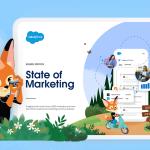Conversational marketing enables businesses to converse with prospects on their website in real time. This kind of engagement can be done via:
- Chatbots
- Voice assistants
- Phone calls
- Live chat
- Conversational AI
This allows for more efficient and personal communication on your social media channels, website, connected home devices, paid ads, and more.
What are the benefits of conversational marketing?
- Companies have a detailed view of who’s visiting their website. This helps them to have meaningful conversations in real time.
- Businesses can leverage data with AI, chat, voice, and more, leading to more personal communication. This is a top priority in the New Normal.
- B2B operators can shift their most qualified prospects to live reps. In an era when buyers are now expecting an “Amazon-like experience”, speed and personal communication are of the essence.
Conversational marketing platforms can help businesses better communicate with their audience, but how can a company create a successful conversational marketing strategy? Here are a few tips to get started.
Top 10 conversational marketing tips to help business growth
1. Use chatbots smartly
Chatbots are beneficial for:
- Easing customer pain points
- Gathering actionable information quickly
- Surfacing content
- Directing prospects towards the best solution
Casper mattresses went even further and created a bot to keep insomniacs company in the wee hours of the morning.
2. Implement self-service options
Not only do self-service options lower the burden on reps, but they can also lead to higher customer satisfaction. Giving customers the option to engage with a live rep is wonderful. It empowers them with the ability to resolve an issue on their own.
3. Boost your social media presence
Many businesses are turning to social media channels to engage with their audience. This includes 1-800-Flowers, which was used as an example by Mark Zuckerberg to demonstrate the power of conversational commerce on Facebook Messenger. Sephora also uses Facebook Messenger to let their customers book appointments based on geo-tagging.
4. Fast-track your qualified prospects to live reps
If self-service options can’t solve an issue, you’ll need to prioritise leads for live support. Conversational marketing platforms enable businesses to identify which leads are most likely to buy and then move them to the front of the line.
5. Use bots to arrange meetings
Deploying bots to qualify prospects and book meetings with a rep is a good way to put the customer at the heart of the conversation. Instead of waiting for reps to return their calls, customers can quickly book a meeting through a bot and move on to other matters.
6. Turn to text messaging
Once meetings with prospects have been booked, you can use text messaging to send helpful reminders as the date nears. Or, you can take a page from Ikea, which uses SMS alerts to inform customers of new products at their branch. Or Reebok, which uses SMS to send out relevant promotional offers. It’s important to remember that these conversational marketing examples are part of a holistic strategy that adds value to the customer experience.
7. Map out the customer experience
As omnichannel experiences become the norm, mapping the customer journey is becoming more important. Creating a map of the customer experience can help businesses pinpoint the places where conversational marketing platforms can ease pain points by connecting prospects to chatbots or live reps.
8. Understand your audience
One of the biggest rewards of conversational marketing is the amount of data it provides. Every time a visitor engages with a chatbot, speaks to a rep, or fills out a survey, they’re generating more information about their needs. Conversational marketing platforms enable reps to see how and where they’re succeeding – and what they can do better.
9. Skill up sales reps
Providing sales reps with training on strategies and tools can help them unlock the full power of conversational marketing. The ability to have real-time conversations with prospects that have already been qualified and prioritised is a time-saver. But it’s important that reps also have the soft skills required for effective conversational marketing. On-demand training platforms like Trailhead can help them get started.
10. Put a premium on conversations
It’s easy to get caught up in analysing what’s converting into pipeline and what’s not. So don’t lose sight of the ultimate goal: building better relationships. Every conversational marketing interaction creates a positive or negative experience for the prospect. And the more positive, personal interactions they have with a company, the more likely they are to become loyal and buy in the future.
Conversational Marketing empowers buyers
Conversational marketing is all about making better connections, both for companies and for customers. It’s about empowering buyers with personal solutions and giving reps the best opportunity to grow the pipeline by prioritising their leads.
Best of all, it leads to faster, more efficient outcomes, and in an age where even a one-second delay can lead to a bad experience, conversational marketing can help businesses build long-term relationships.
Get more insights from 8,200 global marketers in the 7th Edition of Salesforce’s State of Marketing report.
























